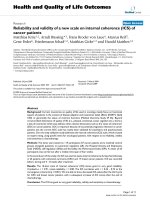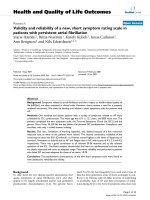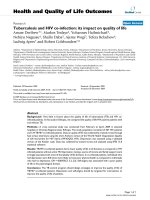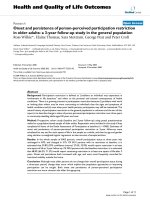báo cáo hóa học:" Tuberculosis and HIVNeeded: A New Paradigm for the Control and Management of Linked Epidemics" pot
Bạn đang xem bản rút gọn của tài liệu. Xem và tải ngay bản đầy đủ của tài liệu tại đây (238.16 KB, 5 trang )
BioMed Central
Page 1 of 5
(page number not for citation purposes)
Journal of the International AIDS Society
Open Access
Commentary
Tuberculosis and HIVNeeded: A New Paradigm for the Control and
Management of Linked Epidemics
Simon J Tsiouris*
1
, Neel R Gandhi
2
, Wafaa M El-Sadr
3
and Friedland Gerald
4
Address:
1
Assistant Professor of Clinical Medicine and Clinical Epidemiology, Division of Infectious Diseases and Department of Epidemiology,
College of Physicians and Surgeons and Mailman School of Public Health, Columbia University, New York, NY,
2
Assistant Professor of Medicine,
Epidemiology & Population Health Divisions of General Internal Medicine and Infectious Diseases, Albert Einstein College of Medicine, New
York, NY,
3
Professor of Clinical Medicine and Epidemiology, International Center for AIDS Care and Treatment Programs, Mailman School of
Public Health, Columbia University and the Division of Infectious Diseases, Harlem Hospital Center, New York, NY and
4
Professor of Medicine,
Epidemiology and Public Health, Yale University School of Medicine, New Haven, Connecticut
Email: Simon J Tsiouris* -
* Corresponding author
Introduction
Tuberculosis (TB) and human immunodeficiency virus
(HIV) disease have been closely entwined since the early
years of the HIV/AIDS pandemic. The 2 conditions over-
lap in their epidemiologic characteristics and clinical
manifestations and are both clothed in stigma. They indi-
vidually carry the risk of creating social, economic, and
political instability, which is markedly worsened when
they affect a region in concert. The overwhelming burden
of disease due to both TB and HIV is borne by resource-
limited countries[1] and the hardest hit among these are
in sub-Saharan Africa.
In sub-Saharan Africa, the HIV epidemic is accelerating
what was already a massive TB epidemic, with the inci-
dence rate of TB increasing from 146 per 100,000 in 1990
to 345 per 100,000 in 2003.[2] Each disease contributes
to the morbidity and mortality of the other. TB is now the
leading cause of death among persons with HIV disease.
HIV increases the risk of reactivation of latent TB infection
(LTBI) and progression to active TB disease more than any
other known risk factor. In some countries, the percentage
of patients with active TB who are coinfected with HIV is
now greater than 60%.[2] Even with appropriate manage-
ment of TB, patients with HIV co-infection have increased
mortality as a consequence of HIV-related complica-
tions.[3]
Diagnostic and Clinical Challenges for Resource-
limited Settings
The rising number of TB/HIV coinfected patients in sub-
Saharan Africa, as well as in other resource-limited areas,
has brought with it and intensified the need to identify
solutions for diagnostic, therapeutic, and management
issues at the interface of both diseases. The recent docu-
mentation of multidrug resistant (MDR) and extensively
drug resistant (XDR) TB among persons coinfected with
HIV and its association with extremely high mortality in
South Africa[4] calls for heightened attention to these
issues and the urgent need for their solutions. Knowledge
and experience in the separate diagnosis and management
of TB and HIV is extensive in resource-rich settings and in
some resource limited settings. However, knowledge and
experience in the diagnosis and management of TB/HIV
co-infection is available in resource-rich settings but
severely limited in resource-poor settings.
HIV co-infection can complicate the clinical presentation
and diagnosis of active TB and limit the sensitivity of the
acid-fast bacilli sputum smear, the most widely (and often
the only) available TB diagnostic method in resource-lim-
ited settings.[5,6] How to overcome this diagnostic obsta-
cle in resource-limited settings is neither known nor well
studied. New TB-specific interferon gamma release assays
are beginning to be studied in TB-HIV co-infected individ-
Published: 25 September 2007
Journal of the International AIDS Society 2007, 9:62
This article is available from: />Journal of the International AIDS Society 2007, 9:62 />Page 2 of 5
(page number not for citation purposes)
uals in resource-limited settings[7,8] as are new rapid
mycobacterial culture and drug susceptibility methods
that have been developed;[9,10] how and if these tests can
be used, and whether their associated cost will be prohib-
itive in these settings is yet to be determined.
Likewise, the treatment of HIV in the setting of active TB
may be complicated by several factors, including additive
toxicities of antiretroviral and anti-tuberculous medica-
tions, drug interactions, risk of immune reconstitution
events, and difficulty in adherence with multiple medica-
tions.[11] Successfully overcoming these hurdles in
resource limited-settings that often have a dearth of diag-
nostic testing capabilities and narrow choices of antiretro-
virals and anti-tuberculous medications requires creative
and inventive solutions. While the coexistence of TB and
HIV epidemics creates added challenges, caring for coin-
fected patients offers opportunities for developing new
paradigms to address the co-epidemics. Through innova-
tive operational research, collaborative training, and inte-
grated treatment efforts, these may improve the
management and outcome of both diseases.
Current vs Alternative Care and Treatment
Paradigms
Although increasing numbers of patients have both con-
ditions, current national TB and HIV programs remain
largely separate with varying levels of interaction and
communication. This programmatic separation often
extends through the entire health care system. While this
characteristic is true of developed countries as well, the far
greater resources available in developed settings can often
compensate for this division and provide adequate care
for co-infected patients. In resource-limited countries,
however, this separation of programs results in care of co-
infected patients that is often fragmented, uncoordinated,
and unsuccessful. It is essential, in areas of high HIV prev-
alence and TB burden, that national TB and HIV programs
collaborate and that care for TB/HIV co-infected individu-
als is integrated at the healthcare delivery level.
Encouragingly, because the leadership of these often sep-
arate TB and HIV programs is usually situated within the
structure of National Ministries of Health, there is the
opportunity for these latter institutions to play a critical
role in establishing and strengthening a coordinated
approach to both diseases thereby ensuring communica-
tion and collaboration between the 2 programs. Rwanda
is an excellent example of such collaboration at the cen-
tral, Ministry of Health level.[12] For effective service inte-
gration to take hold in a widespread manner at the
healthcare delivery level, collaboration has to first exist at
the national level. In some primary care settings, where
resources are extremely limited and personnel even more
so, TB/HIV collaboration and service integration does
occur, but often in an unsupervised, unstructured, and
therefore, suboptimal manner.
The figure depicts stylized representations of 2 different
paradigms for interactions between HIV and TB programs
and service delivery sites: the common current paradigm
and a proposed alternative paradigm. The current com-
mon paradigm is characterized by separate and distinct
programs with little coordination or overlap. The alter-
nate paradigm emphasizes the need for increased commu-
nication, collaboration, and integration of services, in an
effort to improve the care and treatment of TB/HIV co-
infected patients.
Achieving this alternative paradigm requires assessment
of various models of collaboration and integration and
their relevance to the specific setting. These models may
range from maintenance of separate programs and serv-
ices with enhanced communication and referral mecha-
nisms between them to programs that partially or fully
integrate the services they provide. A variety of models of
collaboration and integration will be necessary to suit the
diverse characteristics of a range of settings, for example,
urban vs. rural, high vs. low TB incidence, high vs. low
HIV prevalence. Answers to important question are
needed such as: (1) at what level of prevalence of TB/HIV
co-infection will integration be of most benefit, (2) how
will population density affect the paradigm of collabora-
tion and integration, and (3) how will the cost of imple-
menting integration influence national decision-making?
Ongoing efforts such as those of the National Institutes of
Health-sponsored International epidemiologic Databases
to Evaluate AIDS (IeDEA) study,[13] the Consortium to
Respond Effectively to the AIDS/TB Epidemic (CRE-
ATE),[14] and the Zambia and South Africa Tuberculosis
and AIDS reduction study (ZAMSTAR) may help answer
some of these questions.
Some important progress toward increasing collaboration
between HIV and TB programs and integrating services is
underway. The World Health Organization (WHO) has
formulated recommendations regarding collaboration
and integration and has emphasized the importance of
addressing TB/HIV co-infection in its new "Stop TB" strat-
egy.[15,16] In Rwanda, screening for TB at enrolment into
HIV care and treatment programs and at follow-up visits
using simple symptom questionnaires is being imple-
mented.[17] Additionally, some programs, most notably
Malawi's, have already begun to adopt the public health-
oriented strategies of TB care in newly developed HIV
treatment programs.[18] National-level examples such as
these can serve as models that other countries can adopt
and implement.
Journal of the International AIDS Society 2007, 9:62 />Page 3 of 5
(page number not for citation purposes)
Several individual projects assessing the feasibility of var-
ious collaborative and integrative efforts at the healthcare
delivery level in urban and rural areas have been carried
out or are ongoing. In Rwanda, integration of TB and HIV
services at a district hospital increased HIV counselling
and testing of TB patients and improved TB screening and
case detection in HIV-infected individuals enrolled into
care.[19] In rural KwaZulu-Natal, once-daily antiretroviral
therapy for patients with HIV and TB is successfully being
combined with the existing TB directly observed therapy
program and is using community-based treatment sup-
porters.[20] In Haiti, combined treatment of both TB and
HIV has been shown to be effective both in rural settings
using a community-based treatment model[21] and in
urban settings using a clinic-based approach.[22] These
different experiences in integration of TB and HIV care
and treatment are highly encouraging while at the same
time their examples highlight the technical, program-
matic, staffing and scale-up challenges that remain and
demonstrate that although broad program principles of
TB/HIV collaboration and integration are essential, spe-
cific program components and designs will vary between
and even within countries.[23]
Strengthening the Parts to Strengthen the
Whole
It is important to acknowledge that it may not be possible
to adopt a collaboration strategy in all settings in which
HIV and TB epidemics overlap. One major barrier is the
current situation that TB programs face, that is, their strug-
gle to cope with rising caseloads driven by the HIV epi-
demic in the setting of insufficient structural and human
resources. The additional responsibilities needed to
address TB/HIV co-infection (such as on-site counselling
and testing for HIV and effectively addressing issues of TB
transmission and infection control) may not be feasible in
already overburdened TB programs in certain settings.
Similarly, national HIV programs are overwhelmed by
current HIV treatment scale-up efforts and by the large
number of patients seeking care and treatment. They face
enormous challenges, including the need to train clinical
staff, establish new laboratory services for patients with
HIV and secure an uninterrupted supply of antiretroviral
therapy. Finally, national TB and HIV programs in many
countries may have limited authority to implement col-
laborative models of care, either at the national or local
level.
Action to overcome these barriers is urgently needed. An
infusion of resources to strengthen TB programs, on the
same scale as those received by national HIV programs, is
critical. These resources could be used to improve TB diag-
nostic capabilities, especially as they pertain to HIV-
infected patients, and to expand the number of trained TB
treatment providers and directly observed therapy sup-
porters. As HIV programs establish their care and treat-
ment programs, attention to issues of TB co-infection such
as active TB case-finding, must be included, because TB
represents one of the most common opportunistic infec-
tions that threatens the health of patients with HIV and
carries a dangerous risk of transmission of both drug-sus-
ceptible and drug-resistant TB to others, particularly those
with HIV infection.[4] Lastly, the World Health Organiza-
tion has advocated the creation of national TB/HIV work-
ing groups, which would have the authority to oversee
increased collaboration and integration of TB and HIV
programs and services at both national and local levels.
New Ways of Delivering Integrated Care With
Nontraditional Healthcare Providers
A critically important issue to both TB and HIV programs
is the availability of adequately trained healthcare workers
who will be able to provide the breadth of care necessary
for TB/HIV coinfected patients. Given the limited number
of clinical providers currently available in resource-poor
settings, it is necessary to evaluate the feasibility of using
nonprofessional healthcare workers to serve in auxiliary
roles, such as treatment supporters or directly observed
therapy workers, which provide support to patients'
adherence efforts and monitoring for adverse reactions for
TB/HIV coinfected patients.
These healthcare workers can be drawn from community
or family members, who are a rich source of support avail-
able in many resource-limited settings.[24] The use of
these facilitators and a community care model has been
shown to be effective for delivering TB therapy in other
resource-limited settings[25-27] and may be associated
with favorable clinical and virologic outcomes in patients
with both TB and HIV disease in need of treat-
Common and alternative TB and HIV program paradigmsFigure 1
Common and alternative TB and HIV program para-
digms. C&T = Counseling and Testing; DOT = Directly
Observed Therapy; HIV = Human Immunodeficiency Virus;
IPT = Isoniazid (INH) Preventive Therapy; LTBI = Latent
Tuberculosis Infection; OI = Opportunistic Infection; Px =
Prophylaxis; Rx = Treatment; TB = Tuberculosis
National TB
Program
National TB
Program
Collaboration of Programs
National HIV
Program
National HIV
Program
A Common
TB and HIV Paradigm
An Alternative
TB and HIV Paradigm
TB Services HIV Services
C&T
Antiretrovirals
Ol Rx and Px
Adherence Support
Community Support
HIV Prevention
Sputum Collection
DOT
Treatment Support
Contact Tracing
LTBI Screening
IPT
Integration of Services
Communication
TB Services HIV Services
C&T
Antiretrovirals
Ol Rx and Px
Adherence Support
Community Support
HIV Prevention
Sputum Collection
DOT
Treatment Support
Contact Tracing
LTBI Screening
IPT
Journal of the International AIDS Society 2007, 9:62 />Page 4 of 5
(page number not for citation purposes)
ment.[21,28] Efforts are necessary to determine how to
effectively and safely adapt these models to serve for the
simultaneous treatment of both TB and HIV.
Conclusion
The collaboration between HIV and TB programs and
services has been hampered by their separate traditions
and practices. TB programs are characterized by firmly
established algorithms, standardized measures and out-
comes, and are designed to treat large numbers of patients
with few resources. On the other hand, HIV care and treat-
ment programs are characterized by a patient-centered
approach with rapidly evolving treatment paradigms that
necessitate frequent revisions of treatment guidelines,
accompanied by the need to intensively monitor for effi-
cacy and toxicity over a patient's lifetime. The nuances,
subtleties and added complexities of TB diagnosis and
appropriate management, including the treatment of
drug-resistant TB, in the context of HIV co-infection must
be recognized and incorporated into TB care, as must the
need for a large-scale public health approach for the man-
agement of HIV in resource-limited settings. Each disci-
pline needs to accommodate the other. For the TB world,
HIV should no longer be seen as an intruder and must be
accepted as part of the current and future reality. For the
HIV world, the accumulated experience acquired over the
longer history of TB must be valued and can serve as a
source of important lessons. How to best harmonize these
2 approaches is at the core of what needs to be rapidly
accomplished to effectively manage and control both TB
and HIV. Resources provided by international funding
sources encouraging and even requiring such harmoniza-
tion can contribute to this effort but a new spirit of accom-
modation and collaboration is also required to greatly
benefit patients with TB and HIV and establish a new par-
adigm for the future.
Authors and Disclosures
Simon J. Tsiouris, MD, MPH, has disclosed no relevant
financial relationships.
Neel R. Gandhi, MD, has disclosed no relevant financial
relationships.
Wafaa M. El-Sadr, MD, MPH, has disclosed no relevant
financial relationships.
Gerald Friedland, MD, has disclosed no relevant financial
relationships.
References
1. Dye CSS, Dolin P, Pathania V, Raviglione MC: Consensus State-
ment. Global burden of tuberculosis: estimated incidence,
prevalence, and mortality by country. WHO Global Surveil-
lance and Monitoring Project. JAMA 1999, 282:677-686.
Abstract
2. WHO: Global tuberculosis control: surveillance, planning,
financing. WHO report 2005 2005 [ />tions/global_report/2005/en/]. Geneva: World Health Organization
Accessed July 20, 2007
3. Wilkinson D, Davies GR: The increasing burden of tuberculosis
in rural South Africaimpact of the HIV epidemic [see com-
ment]. South Afr Med J 1997, 87:447-450.
4. Gandhi NR, Moll A, Sturm AW, et al.: Extensively drug-resistant
tuberculosis as a cause of death in patients co-infected with
tuberculosis and HIV in a rural area of South Africa [see
comment]. Lancet 2006, 368:1575-1580.
5. Colebunders RL, Ryder RW, Nzilambi N, et al.: HIV infection in
patients with tuberculosis in Kinshasa, Zaire. Am Rev Resp Dis
1989, 139:1082-1085. Abstract
6. De Cock KM, Soro B, Coulibaly IM, Lucas SB: Tuberculosis and
HIV infection in sub-Saharan Africa. JAMA 1992,
268:1581-1587. Abstract
7. Tsiouris SJ, Coetzee D, Toro PL, Austin J, Stein Z, El-Sadr W: Sensi-
tivity analysis and potential uses of a novel gamma interferon
release assay for diagnosis of tuberculosis. J Clin Microbiol 2006,
44:2844-2850. Abstract
8. Rangaka MX, Diwakar L, Seldon R, et al.: Clinical, immunological,
and epidemiological importance of antituberculosis T cell
responses in HIV-Infected Africans. Clin Infect Dis 2007,
44:1639-1646. Abstract
9. Moore DA, Mendoza D, Gilman RH, et al.: Microscopic observa-
tion drug susceptibility assay, a rapid, reliable diagnostic test
for multidrug-resistant tuberculosis suitable for use in
resource-poor settings. J Clin Microbiol 2004, 42:4432-4437.
Abstract
10. Arias M, Mello FC, Pavon A, et al.: Clinical evaluation of the
microscopic-observation drug-susceptibility assay for detec-
tion of tuberculosis. Clin Infect Dis 2007, 44:674-680. Abstract
11. McIlleron H, Meintjes G, Burman WJ, Maartens G: Complications
of antiretroviral therapy in patients with tuberculosis: drug
interactions, toxicity, and immune reconstitution inflamma-
tory syndrome.
J Infect Dis 2007, 196:S63-S75. Abstract
12. Gasana M, Vandebriel G, Kabanda G, et al.: Tuberculosis in
Rwanda: challenges to reaching the targets. Bull WHO 2007,
85:383-384.
13. International epidemiologic databases to evaluate AIDS: [http://
www.iedea-hiv.org]. Accessed July 20, 2007
14. Consortium to respond effectively to the AIDS/TB epidemic: [http:/
/www.tbhiv-create.org]. Accessed July 20, 2007
15. WHO: Interim Policy on Collaborative TB/HIV Activities.
Geneva: Stop TB Department and Department of HIV/AIDS/WHO 2004
[ />].
Accessed July 20, 2005
16. The Stop TB Strategy: World Health Organization: 2006 [http://
www.stoptb.org/resource_center/assets/documents/
The_Stop_TB_Strategy_Final.pdf]. Report No.: WHO/HTM/STB/
2006.37. Accessed July 20, 2007
17. Vandebriel G, Kabanda G, Turinawe K, Sahabo R, Mugabo J, Gasana
M: Early Results of Implementation of a National Policy on
TB Screening in People Living with HIV Attending ART Clin-
ics in Rwanda. HIV/AIDS Implementer's Meeting 2007, Kigali, Rwanda
2007.
18. Chimzizi RB, Harries AD, Manda E, Khonyongwa A, Salaniponi FM:
Counselling, HIV testing and adjunctive cotrimoxazole for
TB patients in Malawi: from research to routine implemen-
tation.[see comment]. Int J Tuberculosis Lung Dis 2004, 8:938-944.
19. Gasana M, Vandebriel G, Kabanda G, et al.: Integrating tuberculo-
sis and HIV care in rural Rwanda. International Journal of Tubercu-
losis & Lung Disease 2007 in press.
20. Jack C, Lalloo U, Abdool-Karim Q, et al.: A pilot study of once-
daily antiretroviral therapy integrated with tuberculosis
directly observed therapy in a resource-limited setting. J
AIDS 2004, 36:929-934.
21. Koenig SP, Leandre F, Farmer PE: Scaling-up HIV treatment pro-
grammes in resource-limited settings: the rural Haiti expe-
rience. AIDS 2004, 18:S21-S25. Abstract
22. Severe P, Leger P, Charles M, et al.: Antiretroviral therapy in a
thousand patients with AIDS in Haiti.[see comment]. N Engl
J Med 2005, 353:2325-2334. Abstract
23. Friedland G, Harries A, Coetzee D: Implementation issues in
tuberculosis/HIV program collaboration and integration: 3
case studies. J Infect Dis 2007, 196:S114-S123. Abstract
24. Farmer P, Leandre F, Mukherjee J, Gupta R, Tarter L, Kim JY: Com-
munity-based treatment of advanced HIV disease: introduc-
Publish with BioMed Central and every
scientist can read your work free of charge
"BioMed Central will be the most significant development for
disseminating the results of biomedical research in our lifetime."
Sir Paul Nurse, Cancer Research UK
Your research papers will be:
available free of charge to the entire biomedical community
peer reviewed and published immediately upon acceptance
cited in PubMed and archived on PubMed Central
yours — you keep the copyright
Submit your manuscript here:
/>BioMedcentral
Journal of the International AIDS Society 2007, 9:62 />Page 5 of 5
(page number not for citation purposes)
ing DOT-HAART (directly observed therapy with highly
active antiretroviral therapy) [see comment]. Bull WHO 2001,
79:1145-1151. Abstract
25. Miti S, Mfungwe V, Reijer P, Maher D: Integration of tuberculosis
treatment in a community-based home care programme for
persons living with HIV/AIDS in Ndola, Zambia. Int J Tubercu-
losis Lung Dis 2003, 7:S92-S98.
26. Sinanovic E, Floyd K, Dudley L, Azevedo V, Grant R, Maher D: Cost
and cost-effectiveness of community-based care for tubercu-
losis in Cape Town, South Africa. Int J Tuberculosis Lung Dis 2003,
7:S56-S62.
27. El-Sadr W, Medard F, Dickerson M: The Harlem family model: a
unique approach to the treatment of tuberculosis. J Public
Health Manag Pract 1995, 1:48-51.
28. Walton DA, Farmer PE, Lambert W, Leandre F, Koenig SP, Mukher-
jee JS: Integrated HIV prevention and care strengthens pri-
mary health care: lessons from rural Haiti [see comment]. J
Public Health Policy 2004, 25:137-158. Abstract









